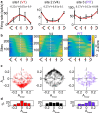End-Stopping Predicts Curvature Tuning along the Ventral Stream
- PMID: 28100746
- PMCID: PMC5242411
- DOI: 10.1523/JNEUROSCI.2507-16.2016
End-Stopping Predicts Curvature Tuning along the Ventral Stream
Abstract
Neurons in primate inferotemporal cortex (IT) are clustered into patches of shared image preferences. Functional imaging has shown that these patches are activated by natural categories (e.g., faces, body parts, and places), artificial categories (numerals, words) and geometric features (curvature and real-world size). These domains develop in the same cortical locations across monkeys and humans, which raises the possibility of common innate mechanisms. Although these commonalities could be high-level template-based categories, it is alternatively possible that the domain locations are constrained by low-level properties such as end-stopping, eccentricity, and the shape of the preferred images. To explore this, we looked for correlations among curvature preference, receptive field (RF) end-stopping, and RF eccentricity in the ventral stream. We recorded from sites in V1, V4, and posterior IT (PIT) from six monkeys using microelectrode arrays. Across all visual areas, we found a tendency for end-stopped sites to prefer curved over straight contours. Further, we found a progression in population curvature preferences along the visual hierarchy, where, on average, V1 sites preferred straight Gabors, V4 sites preferred curved stimuli, and many PIT sites showed a preference for curvature that was concave relative to fixation. Our results provide evidence that high-level functional domains may be mapped according to early rudimentary properties of the visual system.
Significance statement: The macaque occipitotemporal cortex contains clusters of neurons with preferences for categories such as faces, body parts, and places. One common question is how these clusters (or "domains") acquire their cortical position along the ventral stream. We and other investigators previously established an fMRI-level correlation among these category domains, retinotopy, and curvature preferences: for example, in inferotemporal cortex, face- and curvature-preferring domains show a central visual field bias whereas place- and rectilinear-preferring domains show a more peripheral visual field bias. Here, we have found an electrophysiological-level explanation for the correlation among domain preference, curvature, and retinotopy based on neuronal preference for short over long contours, also called end-stopping.
Keywords: V1; V4; curvature; end-stopping; faces; inferotemporal cortex.
Copyright © 2017 the authors 0270-6474/17/370648-12$15.00/0.
Figures







References
-
- Born RT. Center-surround interactions in the middle temporal visual area of the owl monkey. J Neurophysiol. 2000;84:2658–2669. - PubMed
Publication types
MeSH terms
Grants and funding
LinkOut - more resources
Full Text Sources
Other Literature Sources
